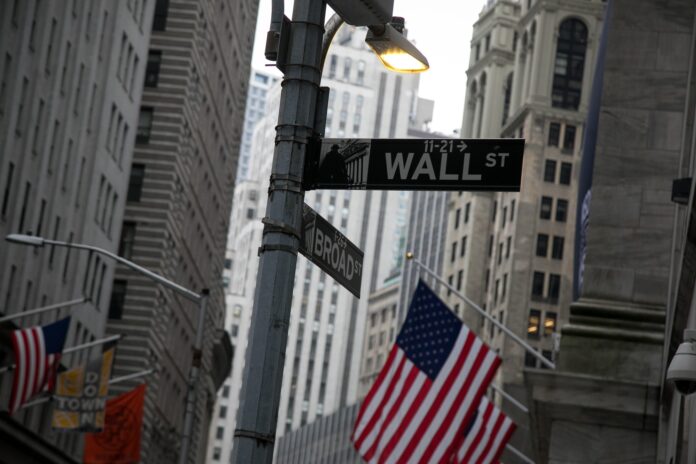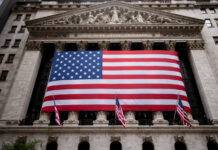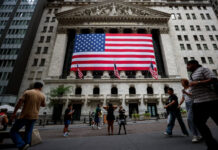
US equity futures posted modest gains as traders prepared for a week packed with data that will shed light on the health of the world’s largest economy and the outlook for Federal Reserve interest rates.
S&P 500 and Nasdaq 100 contracts were about 0.3% higher, while Europe’s Stoxx 600 index pared a 0.5% advance. In London, BT Group Plc rallied more than 7% after Bharti Global agreed to buy a stake of about 24.5% in the UK carrier.
There was some relief for investors Monday from the volatility that ripped through markets in recent sessions, fueled by concerns the Fed is waiting too long to cut rates. The S&P 500 last week posted both its biggest one-day slump and best rebound since 2022.
“We all know that August tends to be a market in which we could see massive volatility simply because the liquidity does tend to be lower,” Sonja Marten, head of FX and monetary policy research at DZ Bank, said in an interview with Bloomberg TV. “This complete overreaction, panic move last week kind of goes to prove that.”
In currencies, the yen dropped the most against the dollar among major peers, giving back some of last week’s surge when traders slashed bearish bets in the wake of the Bank of Japan’s July 31 rate hike. The BOJ’s move prompted investors to dump carry trades, unleashing turmoil that ricocheted across global markets.
The Cboe Volatility Index — Wall Street’s fear gauge — has retreated from its highest levels since the early days of the Covid-19 pandemic. But there’s no certainty the relative calm will continue, with Wednesday’s US inflation data the key volatility event for the week.
According to Citigroup Inc., traders are positioning for the S&P 500 to move 1.2% in either direction when the consumer price index report is released.
Meanwhile, as bond markets have moved to account for a Fed that is “behind the curve,” the risk isn’t “priced into current equity multiples,” according to Morgan Stanley strategists. The team led by Michael Wilson said economic growth is the primary concern for investors, rather than inflation and rates.
“Markets are looking for better growth or more policy support to get excited again,” the team wrote in a note. “We don’t see confirming evidence in either direction near term, leaving the index to trade in a tight range for now.”
Still, investors did take flight from stocks during last week’s wild swings. They reduced their equity allocations at the sharpest pace since the onset of the Covid pandemic, according to data from Deutsche Bank AG.
Aggregate allocation to stocks is now in the 31st percentile and underweight, strategists including Parag Thatte wrote in a note dated Aug. 9. Just three weeks ago, exposure was at the top of the historical range in the 97th percentile.
The US consumer price index is expected to have risen 0.2% from June for both the headline figure and the so-called core gauge that excludes food and energy. The modest moves, however, may not be enough to derail the Fed from a widely anticipated interest-rate cut next month.
At the weekend, Fed Governor Michelle Bowman said she still sees upside risks for inflation and continued strength in the labor market, signaling she may not be ready to support an interest-rate decrease when US central bankers next meet in September. Money markets have fully priced a rate cut in September and about 100 basis points of easing for the year, according to swaps data compiled by Bloomberg.
When it comes to the wild swings seen in markets, “the problem is also that central banks have been emphasizing that they are acting very data-dependent these days,” DZ Bank’s Marten said. “Investors are trading from one data point to the next. That does also create additional volatility.”
Elsewhere on the monetary policy front, the European Central Bank is now seen as likely to cut its deposit rate once a quarter through the end of next year, a timetable that will see its easing cycle end sooner than previously anticipated. A Bloomberg survey of forecasters shows that benchmark hitting 2.25% in December 2025 following six consecutive quarter-point reductions.
In commodities, oil extended its first weekly gain since early July, with traders continuing to monitor Iran’s response to last month’s assassination of a Hamas leader in Tehran. Gold rose to the highest in a week, with traders focused on the week’s key US data. Bullion has gained more than 18% this year and remains in touching distance of last month’s all-time high. Along with rate-cut expectations, it’s also been supported by firm central bank buying and robust demand from Chinese consumers.
Some key events this week:
- India CPI, industrial production, Monday
- Australia consumer confidence, Tuesday
- Japan PPI, Tuesday
- South Africa unemployment, Tuesday
- UK jobless claims, unemployment, Tuesday
- Home Depot earnings, Tuesday
- US PPI, Tuesday
- Atlanta Fed President Raphael Bostic speaks, Tuesday
- Eurozone GDP, industrial production, Wednesday
- New Zealand rate decision, Wednesday
- South Korea jobless rate, Wednesday
- Poland CPI, Wednesday
- UK CPI, Wednesday
- US CPI, Wednesday
- Australia unemployment, Thursday
- Japan GDP, industrial production, Thursday
- Philippines rate decision, Thursday
- China home prices, retail sales, industrial production, Thursday
- Norway rate decision, Thursday
- UK industrial production, GDP, Thursday
- US initial jobless claims, retail sales, industrial production, Thursday
- St. Louis Fed President Alberto Musalem, Philadelphia Fed President Patrick Harker speak, Thursday
- Alibaba Group, Walmart earnings, Thursday
- Hong Kong jobless rate, GDP, Friday
- Taiwan GDP, Friday
- US housing starts, University of Michigan consumer sentiment, Friday
- Chicago Fed President Austan Goolsbee speaks, Friday
Some of the main moves in markets:
Stocks
- S&P 500 futures rose 0.3% as of 8:24 a.m. New York time
- Nasdaq 100 futures rose 0.3%
- Futures on the Dow Jones Industrial Average rose 0.2%
- The Stoxx Europe 600 rose 0.2%
- The MSCI World Index was little changed
Currencies
- The Bloomberg Dollar Spot Index was little changed
- The euro was little changed at $1.0922
- The British pound was little changed at $1.2768
- The Japanese yen fell 0.7% to 147.59 per dollar
Cryptocurrencies
- Bitcoin rose 1.8% to $59,575.57
- Ether rose 4.3% to $2,668.3
Bonds
- The yield on 10-year Treasuries was little changed at 3.93%
- Germany’s 10-year yield was little changed at 2.23%
- Britain’s 10-year yield was little changed at 3.94%
Commodities
- West Texas Intermediate crude rose 1.1% to $77.70 a barrel
- Spot gold rose 0.5% to $2,443.81 an ounce

















